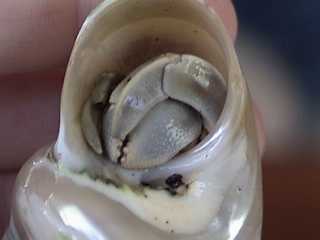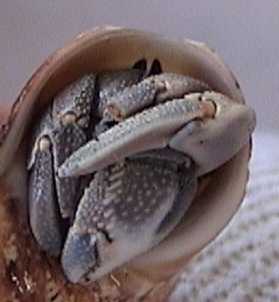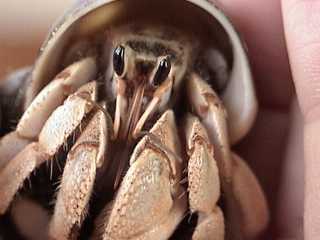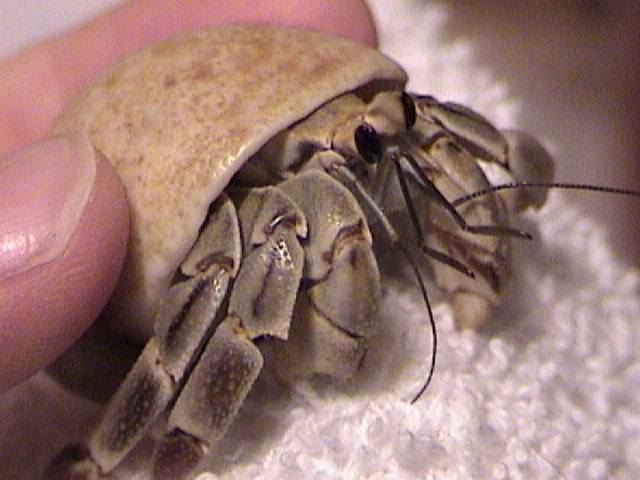


Coenobita
rugosus
All the colors
of the rainbow!
Coenobita rugosus (the "tawny hermit crab") is the most recent species of exotic land hermit crab to arrive in the U.S. Identifying them can be quite a challenge but actually it's easy if you know what to look for. First off, if you suspect that you have C. rugosus, forget anything you've read about coloring, as this crab comes in all colors -- black, blue, gray, peach, tan and even white!
Coenobita rugosus is native to the Pacific islands as well and while most people had heard of them, when the first C. rugosus landed in the U.S., we had a lot of fun trying to identify them. They have eyes and bodies sort of like Ecuadorians, but at the same time are very different. Thankfully, C. rugosus has some great unique body features that will help you to identify it.
To give you an idea of the color variations of Coenobita rugosus, below are some pictures of them. All of these crabs have been definitively identified as C. rugosus:



C. rugosus can look a lot like an Ecuadorian (Coenobita compressus) at first glance. The eyes are elongated, there can be striping on the sides of the body, and when C. rugosus' shell is too small, like the crab in the middle picture, it will adopt the Ecuadorian habit of crossing two legs over the large claw. However, Ecuadorians usually have a lot more color variation on their bodies. For instance, an Ecuadorian crab will be a shade of gray or brown, but have darker-colored feet and striping on the body, while C. rugosus' legs are a more uniform color. Also as you can see in the crab picture in the middle above, some C. rugosuses have quite unique-looking claws. In particular, notice the small diagonal lines across the top of the middle crab's large claw. Those are the "stitch marks" that can be used to help people identify C. rugosus.
Don't rely too much on the "stitch marks" on the outer claw to positively identify your crab, however. Ecuadorian crabs can and do have the same stitch marks on their claws, though they are usually more pronounced on C. rugosus than on the Ecuadorians.
 |
|
|
Ecuadorian crab. Notice how legs
get a lot darker towards the ends and the "pinstriping" on
upper leg segments.
|
Ruggie. Notice the absence of "pinstriping" on body, more delicate eyestalks and legs. |
Special Needs. Ruggies need and love salt water! Especially right after you bring them home from the pet store. They will drink it for hours and hours! They also enjoy exploring every millimeter of their crabitat.
Molting. C. rugosus molts very well in sand or Forest Bedding, so the general molting method described on the Molting page works well for them. When it comes to Ruggies' molting habits, they are very similar to those of the purple pincher or Ecuadorian crabs. They will dig under and molt and then come back up when they are ready.
Temperament. Many crabbers have chosen the ruggie as their favorite species, and for a good reason. Ruggies are often "the best of both worlds," i.e., the sweetness of the purple pincher combined with the activity level of the Ecuadorian. They come out to visit willingly, with antennae a-flutter and a bright, inquisitive expression. Unlike Ecuadorians, ruggies thoroughly enjoy shell-shopping and will often be the first species to check out new shells you've added to the crabitat. Each crab is different, however, so yours might be more of a "hermit" than usual. Some people have mentioned that their Ruggies chirp a lot, but mine vocalize slightly less than the Ecuadorians. Ruggies usually chirp only if another crab is harassing them, though there are always exceptions!
Compatibility. I have been keeping my C. rugusus crabs in a crabitat along with my Ecuadorians and other exotic species. They appear to get along well. Keep an eye on the crabitat initially after introducing ANY new species, to make sure there is no trouble.
Further Research:If you would like to view more pictures and information about identifying this species of hermit crab, please check out the Links page. Some of the websites featured there have more information on exotic land hermit crabs.
Home Page/ Behavior
& Aggression/Basic Care/Chirping/Convention
Happenings/ Sexing/FAQs/Food
& Feeding/My Links/Molting/Nocturnal
Behavior/Shells & Shell Pictures/Species Identification/About Me